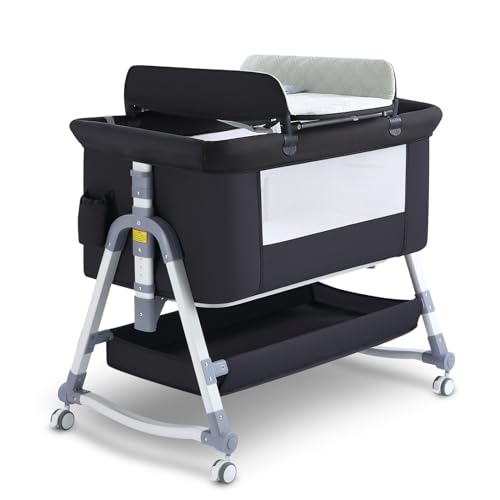Bedside Co-Sleeper - What is a Bedside Co-Sleeper?
A bedside cot co sleeper is a bassinet that attaches to the bed's side, allowing you to reach for baby during the night. This kind of co-sleeping is recommended by the Lullaby Trust and NHS as it allows you to keep your baby close by without risking SIDS.
bedside crib co sleeper of Mind
Co-sleeping is an important parenting choice. Although some parents are worried that sleeping in close proximity to their child will increase the risk of SIDS, studies like those conducted by NHS suggest otherwise. Co-sleeping refers to sharing a sleeping space, which can increase the risk for SIDS. Bedside cots with co sleepers have been designed to provide an appropriate space between bed-sharing and separate sleeping surfaces that allow parents to reach over their child and effortlessly nurse or comfort them without leaving the security of their bed.
Babies sleep best when they are fed and comforted regularly However, exhausted parents may be unable to leave their bed to feed or comfort them. A bedside cot with a co sleeper allows parents to keep their infant in a safe distance and avoid having to leave their comfy bed. Some co sleepers have an innovative design, like the SnuzPod. The four walls can be closed to turn the cot in a cradle, giving an additional layer of security. This allows tired parents to watch their newborns while lying in bed.
Even a small amount of alcohol or drugs could increase the risk of SIDS. Co-sleeping with children is not recommended in the event of a parent with an history of snoring. The NHS suggests that young babies are always sleeping on their backs in order to minimize the risk of accidental rolling and the risk of suffocation. A bassinet or cot at the bedside is the safest method to make sure this is done.
Safety
The NHS recommends that babies be placed in their own cribs instead of having to share your bed. This is due to the higher risk of suffocation and overheating. Babies who sleep with their parents are more likely to be covered by blankets, pillows or sheets. This could lead to SIDS. A bedside crib can be an ideal solution. The crib is located close to the parents, preventing the baby from overheating or suffocating. baby. It can be easily accessible to feed the baby at night and also for comforting.
Parents across the globe were eagerly awaiting the Dutch cosleeping pod when it first became popular in 2004. They wanted to test safe cosleeping. Despite the excitement doctors do not believe in a sleeping bed that is attached to the side of a adult bed.
The main concern is the fact that a parent could roll onto the infant and cause strangulation or suffocation. This is especially true when the parent is asleep while drinking, smoking or taking drugs. Other risks include overheating, the possibility of falling and the risk of a maternal death during pregnancy and following childbirth.
If you choose to purchase a bedside sleeper, it is crucial to select one that meets all safety standards. The mattress should fit comfortably without gaps and shouldn't be susceptible to sliding. It is also important to be aware of the recommended weight and the age of the sleeper.

All new bedside beds will be required to conform to the new safety standard which was launched in November of 2020. It replaces the earlier standards. There may be older models for sale in a few stores but they are gradually disappearing as manufacturers transition to the new safety standards.
Before you buy a used model, check that it's in good shape. Make sure that the mechanism that is used to anchor the bed on the mattress of the parent is sturdy and doesn't leave any gaps. Also, make sure that the mattress fits in the sleeper with no gaps or bulges. Sheets should also fit snugly, so that the baby cannot wriggle down inside and become trapped in a pocket or be at risk of suffocation.
Convenience
Many new parents experience an instinctual desire to be at their baby's side at night, but sleep experts like Lullaby Trust recommend avoiding bed-sharing. Using a bedside crib, or bassinet is a safer option. They are designed to be attached to the sides of parents' bed, allowing baby to be within easy reach for night time feeding and providing comfort. Parents can rest comfortably at the end of the night without having to leave their bed.
Babies sleeping in a separate room are more likely to suffer breathing pauses (apnoea) and are more at risk of SIDS. Research has shown that babies sleep better when they're in close proximity to their parents. You can also quickly respond to any issues or concerns, or even reassure your baby, making them more comfortable.
The ideal bedside bassinet or crib for your family depends on several aspects, including the living situation and future plans. If you share a home with a person who is a friend, or if your child will be using the crib as he grows and develops, it is best to choose a convertible crib that will grow into solitary cribs or toddlers beds. We recommend contacting us to inquire about this option.
The bedside crib helps foster bonding with the baby and mother. It is a convenient and safe choice for new parents who are tired. Studies have proven that breastfeeding mothers tend to nurse longer when their infant is close. This leads to a stronger attachment between the two.
A bedside cot can be an excellent option for mothers who want to keep their baby close to them. When purchasing a bassinet or co-sleeper it is important to make sure that it meets all the Lullaby Trust and safe sleep guidelines. It is also important to be aware of your budget, since there are numerous options to choose from.
